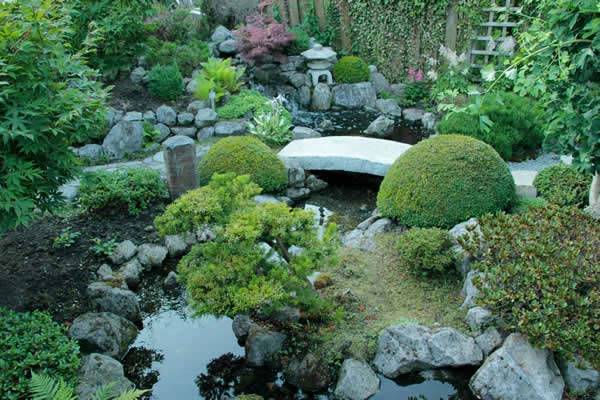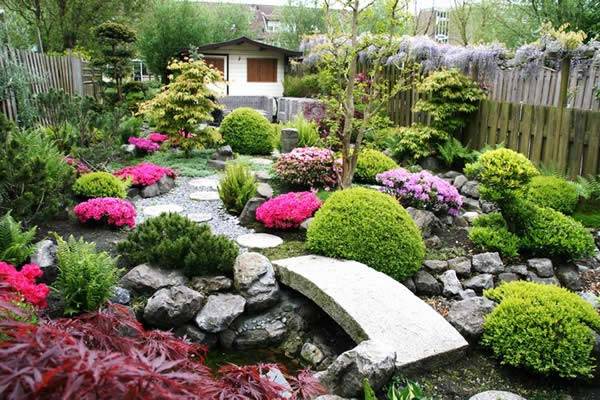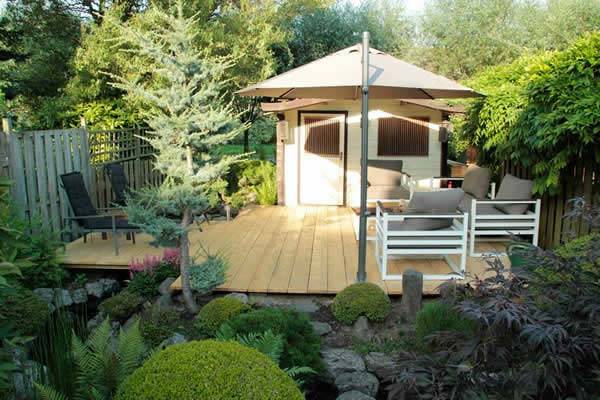In this post, we talk you through the steps involved in creating a Japanese garden. We focus on plants suitable for Japanese Gardens such as Japanese Acers, Azaleas, Bamboo, Cloud Trees, Japanese Camellias and Pine Trees.
We begin with creating a Japanese Garden from scratch and we have been lucky to get some guidance and advice from Ramon Smit who we have been following on Facebook for a while. He has created a beautiful Japanese inspired garden from a blank canvas. Obviously it has taken time to produce the final results but his story shows what can be achieved by either planting up an entire garden or using one-off Japanese plants to create structure and / or colour in an already established garden. Here in his own words is Ramon’s story about creating a Japanese Garden:
Almost 10 Years ago we decided to buy a house with a garden. We were living in an apartment on the 11th floor at the time and we started looking for affordable houses with a garden. We found a house in a place called Gouda an old red brick house from the 1920’s (Yes the place famous for its cheese) with a very nice backyard ( 20m x 7m and by Dutch standards, that’s quite large). Even before we signed the contract I already made a drawing of the garden I had in my mind and was certain it must be a garden in the Japanese Style. My girlfriend was ok with it so (after I promised to make her a sunbathing spot) first we did some work in the house and then I started breaking the old garden down and started from scratch.
The plants I did not want were dug up and taken by the old owner. (I only kept the boxwood shrubs). I dug out all of the grass and started to excavate the stream. I did this all by hand. The grass I turned upside down to make small hills and added the excavated soil. It took some time to finish because the stream was to be 30 meters long and this ends in a small canal behind my garden (lucky me!)
Now it was time to buy some plants. I had done some research in my collection of Japanese garden books so I knew exactly what to buy – maples, azaleas, ferns, pine, hosta, Ginkgo and a 2 meter tall yew Cloud Tree (which I shaped into a garden bonsai) so bought as much as my car could carry and planted them in the garden. Only to find with all the plants in the grounds, the garden was still empty. I had only a small budget so it took a few months of saving before I could buy some more!
Now I needed rocks and stepping stones … a bridge, maybe a small lantern or two? It took me a few years to collect them but with some help from friends and my boss I bought everything from wholesale. The rocks, all 10,600 kg I got thanks to my boss for half the price a normal person would pay. The bridge and steppingstones I got thanks to my friend who owns a bonsai studio (bonsai is another hobby of mine & it’s thanks to that hobby that I became interested in Japanese gardens).
I never really followed a plan, it was all in my head. I built the whole garden around the stream and tried to make it as natural looking as possible – all in the Japanese tradition as far as a non-Japanese person possibly can, that is! With natural scenery in mind and the meandering stream, I was starting to realise my vision after I finally had the rocks to make it look great. I spent 3 weeks positioning the rocks along the stream’s banks and another week to finish the waterfall. I used a rubber butyl liner underneath the stream to hold the water in its place and also underneath the waterfall.

I built the whole Japanese garden around the stream and tried to make it as natural looking as possible
The rocks were delivered to the front of the house. My girlfriend with her mother carried most of the 10,600kg of rocks into the garden by wheelbarrows. Except for the bigger ones which I carried into the garden and laid into the stream’s banks.
Last year I made a whole new terrace made of wood which expands over the stream and built a Japanese gate and fence in the front of the backyard (getting rid of the old conifer hedge).
Here is a list of plants I used for the garden (most of the plants I bought – some of them I dug up out of the gardens of family and friends).
Rhododendrons, Lavendula, Cedrus Atlantica, Ginkgo Biloba , Japanese Azaleas, Acer Palmatum ‘Katsura’, Japanese Acers including Acer Palmatum Atropurpureum, and Acer Palmatum ‘Crimson Queen’, Buxus Sempervirens Globes, Pinus Sylvestris, Pinus Mugho, Abies, Astilbe, Taxus Cloud Tree, Ophiopogon Japonica, Ferns, Moss, Hosta, Juniperus, Equisetum Japonicum & Wisteria.
Most of the plants I prune into ball shapes. I prune the azaleas and boxwood with a hedge clipper after the flowers are gone. You can do that until the end of August (because most azaleas produce new flower buds before winter). You can trim Boxwood maybe 3 times in the growing season followed by a hand of organic fertilizer on the roots.
Trees are shaped into garden bonsai cloud shapes or as the Japanese call it ‘Niwaki’ (I chose to give it a try myself). Japanese Cloud Trees which can be purchased already shaped are expensive because of the age and many years of work involved.
My inspiration comes entirely from Japanese garden books and pictures of Japanese gardens and natural scenery, like streams and waterfalls I found on the internet. The rest is all my imagination ….I’m just really fascinated by Japanese Gardens and I love the tranquillity and the serene looks they radiate …. hoping I could only come close to the real work of Japanese gardeners.
I have a green background- I studied to be a gardener but never worked as one … so it’s just a hobby.
We at Paramount Plants would like to say thank you to Ramon for his insight into creating a Japanese Garden. We would say that his garden is definitely very true to the Japanese Garden style and his story is inspirational! What a fabulous hobby to have…
What is the story of your garden?
We always welcome more stories about creating Japanese or other style gardens to inspire our blog readers.
More to follow later on Japanese Plants and Gardens so keep reading….









